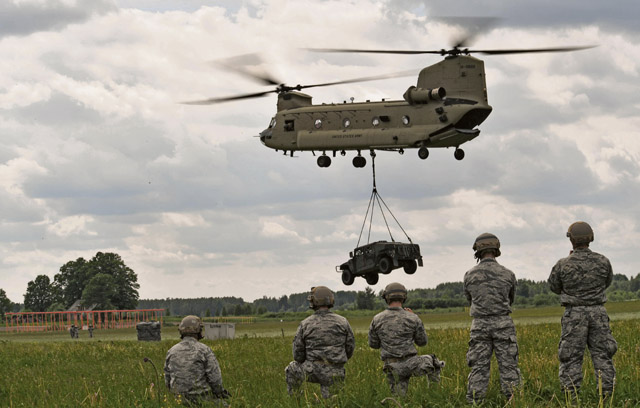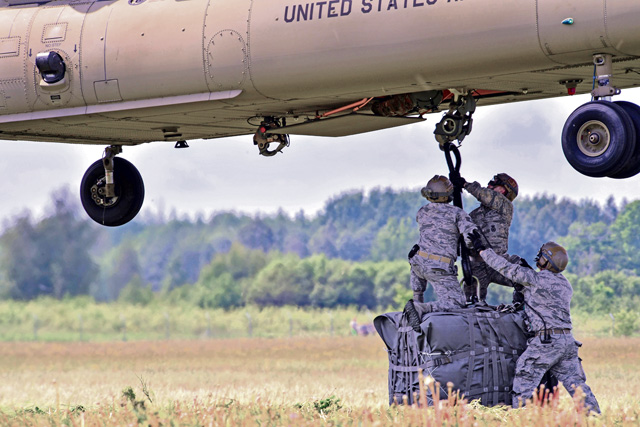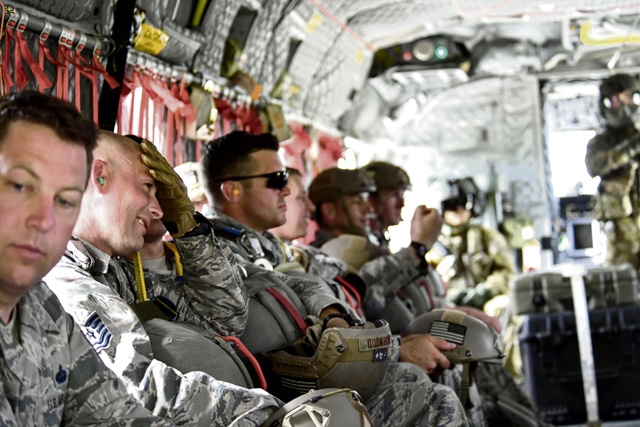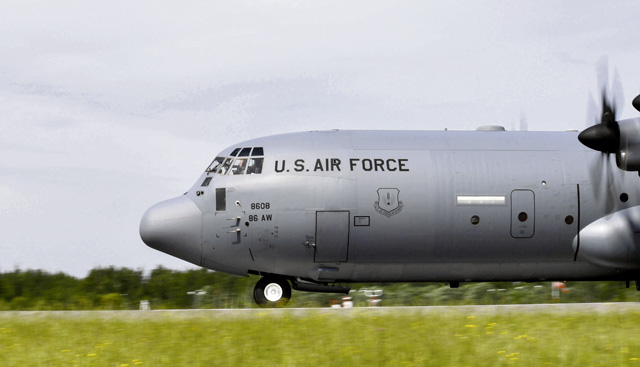
LIELVARDE AIR BASE, Latvia — A U.S. Air Force C-130J Super Hercules from the 86th Airlift Wing roars overhead as a pallet of equipment is pushed from the back, plummeting to the ground before it’s mad decent is softened by the whoosh of a deploying parachute. A strong wind whips dandelion seeds into the air and the C-130 is forced to land instead of dropping paratroopers onto the grassy field as well.
Airmen from Ramstein were operating out of Lielvarde Air Base, Latvia, for exercise Saber Strike 17 from June 5 to 15.
“This training objective is basically to identify that we can do our primary mission, which is to open the base,” said Tech. Sgt. George Broom, 435th Contingency Response Squadron airfield manager. “The 435 CRG has demonstrated it’s capable of an air insertion or a land insertion during this exercise.”

After U.S. Marines or Soldiers have secured an area in an austere environment, it is the 435 CRG Airmen who are the first to touch ground and ensure mission capabilites are ready. Whether it is a grassy field, or dirt strip, they drop cargo, parachute out and land nearby to finish unloading and then begin assessing the area as a potential airfield.
Within four hours, the contingency Airmen make their assessment and reach back to their headquarters with information about the area, where it is determined as a “go” or “no-go” as a safe place for aircraft to land.
For the exercise, Airmen have worked alongside the U.S. Army to complete their air drops.
“My function is to make sure the air drops are done in a safe manner on the drop zone, and that there are no injuries to any personnel or damage to containers being dropped, and to ensure wind conditions are good,” said Staff Sgt. Ellsworth Cupid, 5th Quartermaster Theater Aerial Delivery Company airdrop equipment supervisor and operations foreman. “We have certain regulations for when you can, and can’t, drop; so my job is to make sure that happens.”
After completing their primary mission of assessing the area and opening a base, the Airmen and Soldiers continued to work together with the Latvian military on sling load operations, cargo deployment system drops, landing zone operations, convoy driving training, and night vision goggle training for loading and unloading aircraft.
“Exercises like this are very important for interoperability, partnership, and learning how each other function,” Cupid said. “When we deploy, it’s not just us in theater, you find all these different troops of different nationalities. Instead of waiting until then to learn each other’s systems and how we can work together, it’s better to do it now and figure it out. When we are in a crisis situation, we’ll already have that good partnership established. The Latvians are very receptive, professional, and they are very willing to help us.”

Building and strengthening partnerships throughout the Baltic region and with NATO allies has been a goal for the Saber Strike exercises in the past, and this iteration is no different.
“The Latvians are great,” Broom said. “The U.S. Army already has helicopter units here, so they’re well versed in working with U.S. forces. As far as we’re concerned, I’ve personally interacted with the airfield manager and they gave us all the information and escorts we needed. It’s always good to build those relationships with our NATO partners.”
“For me personally, it’s nice to be able to interact with a NATO nation I’ve never interacted with before,” he continued. “It’s great coming out here, making friendships, learning what their capabilities are, and seeing where you fit into the big puzzle.”

It is only through practice and experience that Airmen can become proficient at what they do. Exercises like Saber Strike 17 give the 435 CRG the ability to put its Airmen to the test.
“As with anything, practice like you play,” Broom said. “The more often we do this, the easier it is to work out the best practices and most efficient way of doing things. It’s always good to train like you’re going to be really doing it. We do it often and we do it well, whether it’s wet, dry, cold, or hot.”
Saber Strike 17 provides an environment for U.S. military forces to work together as well as with their NATO counterparts. Airmen showed they are capable of effectively and efficiently completing their mission working alongside anyone, anywhere.


